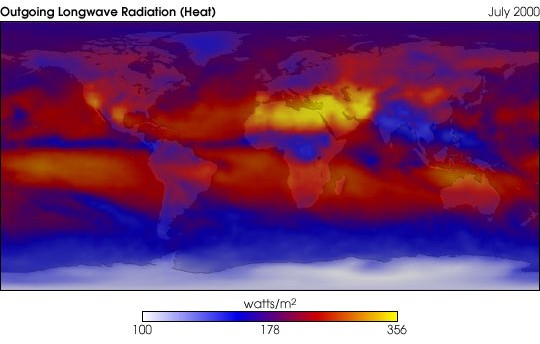|
|
 |
|
|
|
 |
| |
|
|
 |
Clouds and Particles
Basics |
Clouds and climate
Clouds reflect one part of the sunlight to the space. Hence, less solar energy reaches the ground. However, clouds are impish and it is not the only way they affect climate. Have you ever notice that the night is less cold when the sky is cloudy? Let us explain you why...
|
|
|
|
|
 |
Infrared radiations
Do not forget that sunlight is in reality composed of several « parts », including a visible part (which, of course…we see), and ultraviolet and infrared radiations, which human eyes don’t see.
Some animals see ultraviolet radiations (like the bee); others detect infrared (like snakes, for example). We can't see infrared radiations but we can feel it as heat.
|
 |
 |
|
1. Earth from space. Source: NASA.
|
|
 |
Most of the ultraviolet radiations are hopefully stopped by the ozone layer, thus protecting us from their damaging effects. This is why ozone layer is so important.
Atmosphere, oceans, and above all, clouds send back to the space one part of the sunlight (this fraction of reflected light is called albedo). This is why astronauts can see the Earth from space. |
|
Around 70% of solar energy finally arrives on the planet’s surface, the majority being absorbed.
Just as our skin warms up when the sun is shining, the Earth also warms and then reemit infrared radiations.
|
 |
 |
|
2. this image shows the average amount of heat (in Watts per square meter) that was emitted from the Earth back into space during a day in July 2000. Yellow colours show where more heat (or outgoing radiation) is escaping the top of the atmosphere. Purples and blues show intermediate values and white colour shows the lowest values. Desert regions emit a lot of heat, while the snow and ice-covered continent of Antarctica emit very little heat. Source: NASA.
|
If all the infrared radiations were sent back to the space without being trapped, our planet’s temperature would be -18°C: only polar bears would be happy!
|
 |
 |
 |
|
3. A baby polar bear and its mum. Source: USFWS.
|
|
Clouds greenhouse effect
Our planet is not so cold because of the greenhouse effect (more details can be found in the lower atmosphere Unit), which is due to water vapour, clouds and to some gases.We will only explain here the role of clouds.
Clouds cover about 50% of the Earth’s surface. When a cloud absorbs radiation emitted by the Earth's surface, the cloud reemits a portion of the energy to outer space and a portion back toward the surface, thus warming our planet . That’s why they have the capability for reducing the temperature difference between day and night.
During the day, the ground is warmed up by the sunshine. The less clouds in the atmosphere, the more the surface is heated.
During the night, if there is no clouds, most of the infrared radiations emitted by the Earth are send back to the space. The night is cold.
If the sky is cloudy, one part of the radiations is trapped by the cloud, that reflect it back to the Earth's surface. Thus the temperature of the air above the ground is warmer that it would have been without clouds.
|
 |
 |
4. Without clouds during the night, the night is cold.
Source: J. Gourdeau |
|
 |
 |
 |
5. With a cloudy sky during the night, the ground gets less cold because the clouds send back to the surface the infrared radiations. |
|
|
The temperature in the desert shows great differences between day and night because the air is so dry that heat escapes rapidly at night. The night time temperature can be 35°C under the day one.
|
Clouds climate forcing
To summarize, clouds can warm the Earth by trapping heat beneath them: this is called "cloud greenhouse forcing". This process tends to cause a heating or "positive forcing" of the Earth's climate. But clouds can also cool our planet by reflecting the sunlight back into space. The balance of this opposing cloud albedo and cloud forcing determines whether a certain cloud type will tend to warm our planet or produce a cooling effect.
|
 |
 |
|
6. Cloud Forcing determined from 1985 to 1986. The areas where cooling is the greatest are represented by colors that range from yellow to green to blue. In some areas, the effect of the clouds is to produce some warming as shown by colors that range from orange to red to pink. Source:NASA Langley Research Center.
|
|
 |
High thin clouds like cirrus contribute to heating , whereas cooling effect prevails for low thick stratocumulus clouds.
Nowadays, scientists think that the global effect of clouds is to lower the Earth’s temperature. |
|
Knowing whether clouds will warm or cool our planet in case of an enhancement of Earth’s temperature due to human activities is now one of the major scientific challenges for the future: if the global temperature rise, more vapour will be available, therefore leading to more clouds: will they reflect more sunlight back to space or trap more heat energy in the atmosphere?
|
About this page...
Author: J. Gourdeau, LaMP Clermont-ferrand, France.
Scientific reviewer: Dr Vincent Giraud, LaMP, France.
Date of generation: 2003-11-21. Last version: 2004.04.20. |
|
 |
|









